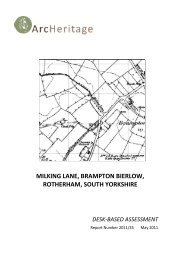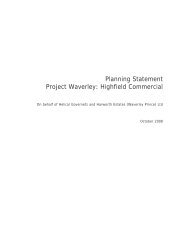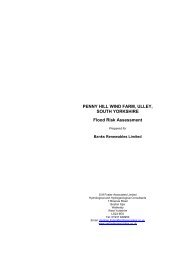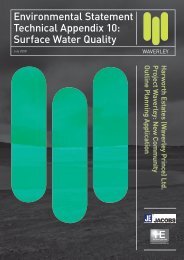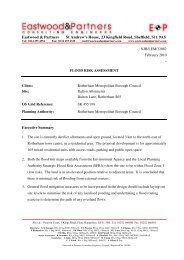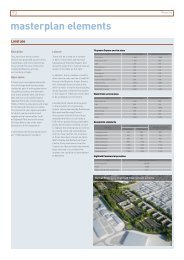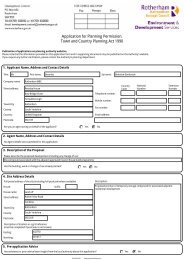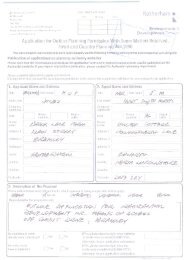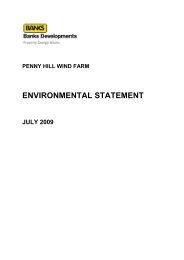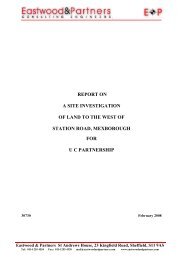environmental statement - Rotherham's Online Application for ...
environmental statement - Rotherham's Online Application for ...
environmental statement - Rotherham's Online Application for ...
You also want an ePaper? Increase the reach of your titles
YUMPU automatically turns print PDFs into web optimized ePapers that Google loves.
assessment were the target areas of the evening activity surveys. The<br />
surveys began 30 minutes after sunset and lasted approximately two<br />
hours. The surveys utilised recognised bat detector equipment and<br />
followed recognised survey techniques.<br />
Roost surveys were undertaken on two trees and the buildings at Ulley<br />
Beeches. A dawn survey was undertaken on each of the trees during<br />
June 2008 respectively. The roost surveys undertaken on the buildings<br />
at Ulley Beeches, involved both a dusk and dawn survey, and were<br />
undertaken during August 2008. The conditions <strong>for</strong> all roost surveys<br />
were ideal, being mild, fine, with no or little breeze.<br />
Badger Survey: The badger survey was undertaken in June 2008 and<br />
involved a search of the field boundaries and woodland within the<br />
Ecological Survey Area. The purpose of the survey was to assess the<br />
suitability of the habitat <strong>for</strong> badgers and to determine<br />
presence/absence of the species. The survey was based on a search<br />
<strong>for</strong> the following recognised field signs <strong>for</strong> badger: setts, paths,<br />
excavations, hair, footprints, dung pits, feeding evidence and bedding<br />
trails. As the survey was undertaken in June, the vegetation present<br />
was at its most vigorous and it was there<strong>for</strong>e difficult to identify field<br />
signs indicative of activity. However, it is considered that setts would<br />
still be evident.<br />
Otter Survey: Watercourses considered suitable <strong>for</strong> otter were<br />
surveyed. The otter surveys were undertaken in May 2008 on two<br />
watercourses within the study area. These watercourses are branches<br />
of Ulley Brook, one which borders the northern extent of the study area<br />
(outside of the application site boundary) and one which borders the<br />
south west of the study area flowing south from Carr Lane. The<br />
purpose of the surveys was to assess the suitability of the<br />
watercourses <strong>for</strong> otter and ultimately to determine presence/absence of<br />
otter within the site. The survey was based on a search <strong>for</strong> the<br />
following recognised field signs <strong>for</strong> otter: spraints, anal jelly, footprints,<br />
paths, flattened vegetation, holts & „couches‟ and feeding remains.<br />
Water Vole Survey: Watercourses considered suitable <strong>for</strong> water vole<br />
were surveyed. The water vole surveys were undertaken in May 2008<br />
on two watercourses within the study area (the northern and southern<br />
branches of the Ulley Brook). The purpose of the surveys was to<br />
assess the suitability of the watercourses <strong>for</strong> water vole, and ultimately<br />
to determine presence/absence of water vole within the study area.<br />
The survey was based on a search <strong>for</strong> the following recognised field<br />
signs <strong>for</strong> water vole: faeces, latrines, feeding stations, burrows, lawns,<br />
nests, footprints, runways, and the distinctive sound of water voles<br />
hitting the water.<br />
White Clawed Crayfish Survey: Watercourses considered suitable <strong>for</strong><br />
white-clawed crayfish were surveyed. The survey was undertaken in<br />
May 2008 on two watercourses within the study area by suitably<br />
171<br />
Penny Hill Wind Farm<br />
Environmental Statement



